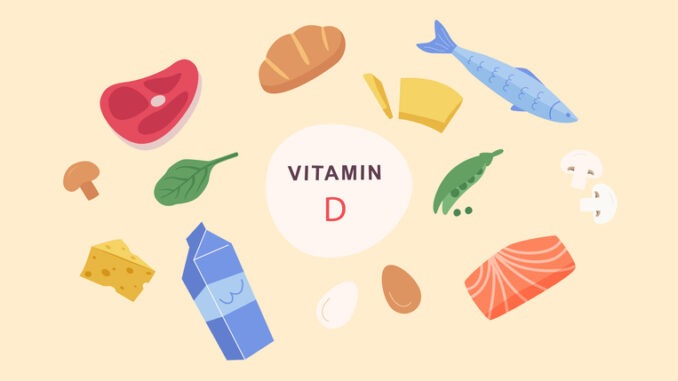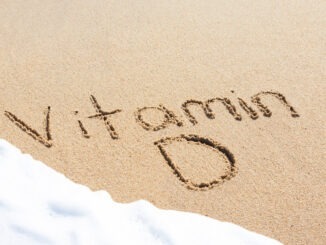
Dr Paul Lambden discusses vitamin D – why we need it, and where we get it from
Vitamin D is required for building and maintaining healthy bones and also regulates a variety of other cellular functions in the body. It is manufactured in the skin in the presence of sunlight but deficiency states are now more commonly seen because of the liberal use of sunscreens, less time spent outside and, in Asian cultures, the wearing of dress which covers up virtually all the skin.
In humans, vitamin D is unique in its ability to be ingested as vitamin D3 (colecalciferol) or vitamin D2 (ergocalciferol). It is also found in oily fish, such as mackerel, sardines and salmon, liver, meat, eggs, fortified breakfast cereals and fortified powdered milk. In the UK, cow’s milk is not fortified and, therefore, is not a good source.
These sources may only represent 10% of intake – in most mammals 90% of vitamin D is manufactured from cholesterol in the skin and can be synthesised in adequate amounts when the skin is exposed to sunlight (ultraviolet irradiation). Indeed, with a balanced diet, and taking advantage of the summer sun, all normal vitamin D requirements should be met.
Vitamin D deficiencies
Vitamin D is essential for the absorption of calcium and phosphorus – which are necessary for the maintenance of healthy bones. Some authorities also believe it to be an important factor in fighting off infections such as colds, reducing the risk of multiple sclerosis and, possibly, even reducing the risk of developing cancer. For some people with psoriasis, a topical application of vitamin D or calcipotriene, a vitamin D-containing compound, may be effective in treating the thicker plaques which form in the condition.

The bone requirement of vitamin D is to prevent rickets and osteomalacia. Rickets is a childhood disease where deficiency of vitamin D (and calcium or phosphorus) results in impaired growth of the long bones which become soft and bow outwards. It became common in deprived areas in the industrial revolution but is relatively rarely seen today in the United Kingdom. Osteomalacia is a bone-thinning disorder that occurs exclusively in adults and is associated with fragile bones and muscle weakness. Both conditions can be treated with supplementation.
Replacement of vitamin D has recently been the subject of many recommendations by different authoritative advisers. In general, between late spring and early autumn, most people should be able to make sufficient vitamin D for their bodily requirements from sunlight exposure. During the winter, the risk of vitamin D deficiency is common. Children above one year old and adults need about 10 microgrammes (µg) a day; a microgramme is one thousandth of a milligram.
During the UK winter there is not enough UVB to allow synthesis, meaning that the body relies more heavily on dietary intake and its summer stores – however, experts agree that patients should not be encouraged to deliberately seek out prolonged sun exposure in order to boost vitamin D levels as the risks of developing skin cancers, and other sun-related skin damage, outweigh the potential benefit. Sunscreens which protect against UVB radiation do reduce the level of vitamin D synthesis, but, again, it would be unwise to recommend that such measures be abandoned. Short, frequent, periods of sun exposure are considered to be safer and should provide adequate opportunity for vitamin D synthesis.
Apart from lack of exposure to sun, deficiency may occur for a number of reasons:
- Following a strict vegan diet, because most sources are animal-based (fish, fish oils, egg yolk, liver)
- Older adults with dark skin are at greater risk of vitamin D deficiency.
- Bowel diseases, such as Crohn’s disease or cystic fibrosis, impair intestinal absorption.
- Obese people often have low vitamin D.
Treatments
If your GP suspects that you are failing to make enough vitamin D, the blood level of the vitamin can be checked with a simple blood test. When the sun is inadequate to supply the UV requirements to make vitamin D, a supplement should be considered; such supplements can be purchased from pharmacies and supermarkets. Adults are advised by the Department of Health to take 10 µg a day throughout the year if they are housebound, institutionalised, wear full body cover clothing or if they have an African, Afro-Caribbean or Asian background. Concomitant administration of calcium is not recommended. Regular consumption of vitamin D-containing foods as part of a balanced diet will help maintain adequate vitamin D levels after deficiency has been treated.
Although care should be taken with sun exposure, it is not possible to overdose on vitamin D manufactured through exposure to sunlight. It is, however, possible to take too much vitamin D, a condition known as hypervitaminosis D. Only fat-soluble vitamins have diseases of excess (i.e., A and D) whereas excess water-soluble vitamins (i.e. B and C) are simply passed out in the urine. Excess vitamin D causes raised blood calcium levels with resulting calcification of soft tissues, the heart and kidneys, amongst other organs. In the kidney it may produce kidney stones. Bones may become weaker. Other symptoms may include anorexia, constipation, fatigue, irritability and muscle weakness. Vitamin D toxicity is reversed by withdrawing supplementation and reducing calcium intake.
Vitamin D levels can be re-checked three months after treatment has been started. Some patients may require longer-term replacement. In rare cases a patient may not respond to standard treatment, and referral to a hospital specialist may be required.



Be the first to comment